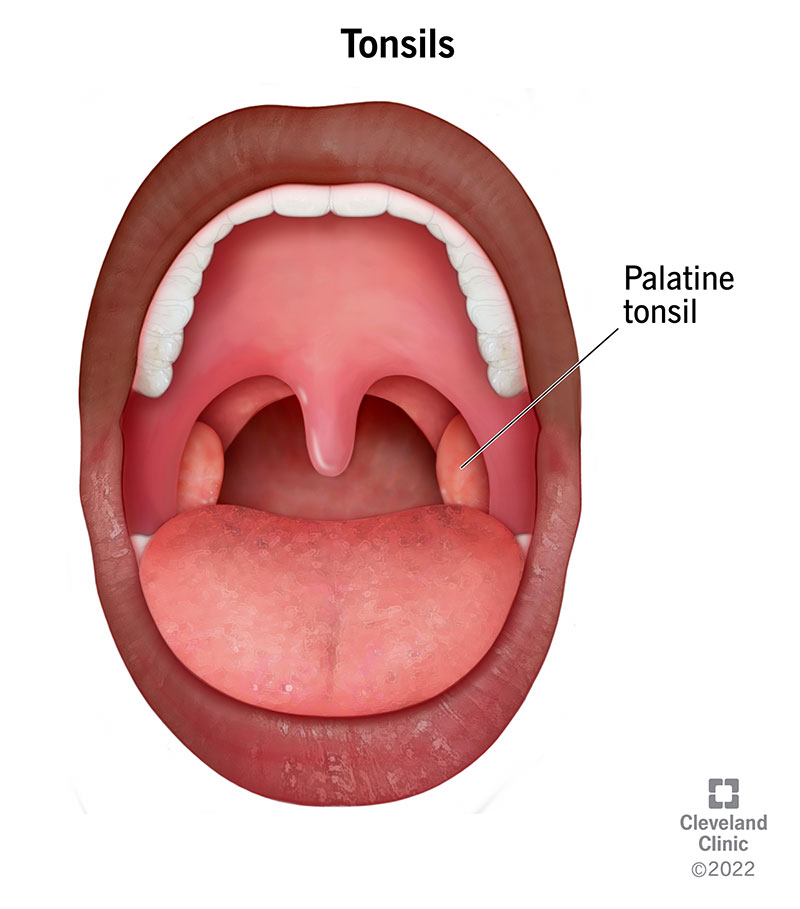Your tonsils, located in the back of your throat, are part of your immune system. They help fight infection and disease. Sometimes, you can develop issues with your tonsils, such as pain, swelling and infection. If these issues are chronic, your healthcare provider might recommend a tonsillectomy (tonsil removal).
Advertisement
Cleveland Clinic is a non-profit academic medical center. Advertising on our site helps support our mission. We do not endorse non-Cleveland Clinic products or services. Policy

Your tonsils are two round, fleshy masses in the back of your throat (pharynx). Part of your immune system, your tonsils are like lymph nodes. They help filter out germs that enter through your nose or mouth to protect the rest of your body from infection. Tonsils are also called palatine tonsils or faucial tonsils.
Advertisement
Cleveland Clinic is a non-profit academic medical center. Advertising on our site helps support our mission. We do not endorse non-Cleveland Clinic products or services. Policy
Sometimes tonsils can become red, swollen or infected. If this issue becomes chronic or doesn’t get better, your healthcare provider might recommend a tonsillectomy (tonsil removal). Typically, people who have their tonsils removed can still fight off infection without any problems. Your body can find other ways to combat germs.
The main function of tonsils is fighting infection. Your tonsils contain a lot of white blood cells, which help kill germs. As your tonsils are in the back of your throat, they can “catch” germs that enter your body through your nose or mouth.
Your tonsils are near the back of your throat, just behind your soft palate. There are two of them — one on each side.
If you still have your tonsils, you can see them when you open your mouth wide and look in the mirror. They’re oval-shaped, pinkish mounds of tissue located on each side of your throat.
Healthy, normal tonsils are pinkish in color. But your tonsils can appear red and swollen if they’re inflamed or infected.
Tonsil size varies significantly from person to person. But based on one research study:
Advertisement
To put this into perspective, each of your tonsils is slightly larger than a marshmallow.
There are a few different conditions that can affect your tonsils. The most common is tonsillitis — an infection of the tonsils. Bacteria and viruses can cause tonsillitis, and the infection can be short-term (acute) or long-term (chronic). The most common tonsillitis symptoms include a sore throat and swollen tonsils.
Other conditions that can affect your tonsils include:
Yes. If your healthcare provider suspects an issue with your tonsils, they may recommend:
Treatment for inflamed or infected tonsils depends on the underlying cause. For example:
Advertisement
In general, you can reduce your risk for bacterial and viral infections with frequent handwashing. You should also avoid sharing food, beverages or eating utensils with someone who’s sick.
If you’re prone to tonsil stones, you can try to prevent them by practicing good oral hygiene. This includes brushing and flossing daily and visiting your dentist for regular checkups.
But it’s important to understand that some people are just more vulnerable to tonsil infections. Aside from tonsillectomy, there may not be a surefire way to prevent the problem from returning. That’s why your provider may recommend a tonsillectomy if other treatments don’t solve the issue.
Tonsillectomy is most commonly done in children with frequent tonsil infections. But adults can have tonsillectomies, too.
Healthcare providers often recommend tonsillectomy for people who have chronic sore throats. For example, if you’ve had several throat infections in the last one to three years, it might be time to consider a tonsillectomy.
Your tonsils are small but mighty. When they function normally, they help shield your body from many different types of infections. But if your tonsils get infected frequently, it might be time to consider a tonsillectomy. To learn more about your tonsils and the procedures that can treat them, talk to your healthcare provider.
Advertisement
Not just kids need a tonsillectomy. Adults who have frequent sore throats or snore a lot get them, too. Cleveland Clinic is here to help.

Last reviewed on 07/08/2022.
Learn more about the Health Library and our editorial process.